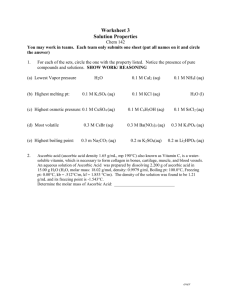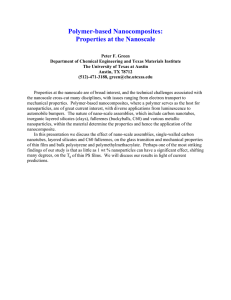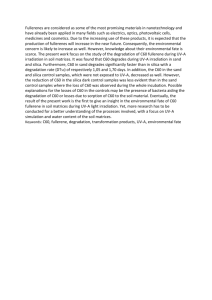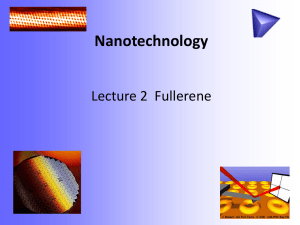Advance Journal of Food Science and Technology 11(3): 212-219, 2016 DOI:10.19026/ajfst.11.2399
advertisement
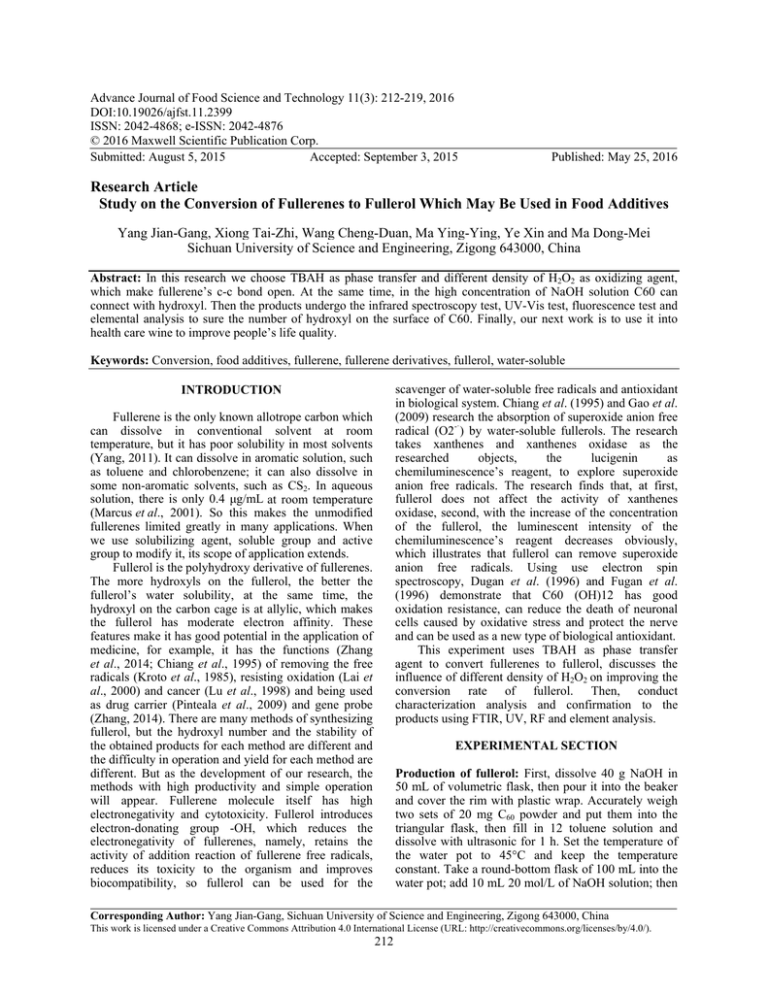
Advance Journal of Food Science and Technology 11(3): 212-219, 2016 DOI:10.19026/ajfst.11.2399 ISSN: 2042-4868; e-ISSN: 2042-4876 © 2016 Maxwell Scientific Publication Corp. Submitted: August 5, 2015 Accepted: September 3, 2015 Published: May 25, 2016 Research Article Study on the Conversion of Fullerenes to Fullerol Which May Be Used in Food Additives Yang Jian-Gang, Xiong Tai-Zhi, Wang Cheng-Duan, Ma Ying-Ying, Ye Xin and Ma Dong-Mei Sichuan University of Science and Engineering, Zigong 643000, China Abstract: In this research we choose TBAH as phase transfer and different density of H2O2 as oxidizing agent, which make fullerene’s c-c bond open. At the same time, in the high concentration of NaOH solution C60 can connect with hydroxyl. Then the products undergo the infrared spectroscopy test, UV-Vis test, fluorescence test and elemental analysis to sure the number of hydroxyl on the surface of C60. Finally, our next work is to use it into health care wine to improve people’s life quality. Keywords: Conversion, food additives, fullerene, fullerene derivatives, fullerol, water-soluble scavenger of water-soluble free radicals and antioxidant in biological system. Chiang et al. (1995) and Gao et al. (2009) research the absorption of superoxide anion free radical (O2-·) by water-soluble fullerols. The research takes xanthenes and xanthenes oxidase as the researched objects, the lucigenin as chemiluminescence’s reagent, to explore superoxide anion free radicals. The research finds that, at first, fullerol does not affect the activity of xanthenes oxidase, second, with the increase of the concentration of the fullerol, the luminescent intensity of the chemiluminescence’s reagent decreases obviously, which illustrates that fullerol can remove superoxide anion free radicals. Using use electron spin spectroscopy, Dugan et al. (1996) and Fugan et al. (1996) demonstrate that C60 (OH)12 has good oxidation resistance, can reduce the death of neuronal cells caused by oxidative stress and protect the nerve and can be used as a new type of biological antioxidant. This experiment uses TBAH as phase transfer agent to convert fullerenes to fullerol, discusses the influence of different density of H2O2 on improving the conversion rate of fullerol. Then, conduct characterization analysis and confirmation to the products using FTIR, UV, RF and element analysis. INTRODUCTION Fullerene is the only known allotrope carbon which can dissolve in conventional solvent at room temperature, but it has poor solubility in most solvents (Yang, 2011). It can dissolve in aromatic solution, such as toluene and chlorobenzene; it can also dissolve in some non-aromatic solvents, such as CS2. In aqueous solution, there is only 0.4 μg/mL at room temperature (Marcus et al., 2001). So this makes the unmodified fullerenes limited greatly in many applications. When we use solubilizing agent, soluble group and active group to modify it, its scope of application extends. Fullerol is the polyhydroxy derivative of fullerenes. The more hydroxyls on the fullerol, the better the fullerol’s water solubility, at the same time, the hydroxyl on the carbon cage is at allylic, which makes the fullerol has moderate electron affinity. These features make it has good potential in the application of medicine, for example, it has the functions (Zhang et al., 2014; Chiang et al., 1995) of removing the free radicals (Kroto et al., 1985), resisting oxidation (Lai et al., 2000) and cancer (Lu et al., 1998) and being used as drug carrier (Pinteala et al., 2009) and gene probe (Zhang, 2014). There are many methods of synthesizing fullerol, but the hydroxyl number and the stability of the obtained products for each method are different and the difficulty in operation and yield for each method are different. But as the development of our research, the methods with high productivity and simple operation will appear. Fullerene molecule itself has high electronegativity and cytotoxicity. Fullerol introduces electron-donating group -OH, which reduces the electronegativity of fullerenes, namely, retains the activity of addition reaction of fullerene free radicals, reduces its toxicity to the organism and improves biocompatibility, so fullerol can be used for the EXPERIMENTAL SECTION Production of fullerol: First, dissolve 40 g NaOH in 50 mL of volumetric flask, then pour it into the beaker and cover the rim with plastic wrap. Accurately weigh two sets of 20 mg C60 powder and put them into the triangular flask, then fill in 12 toluene solution and dissolve with ultrasonic for 1 h. Set the temperature of the water pot to 45°C and keep the temperature constant. Take a round-bottom flask of 100 mL into the water pot; add 10 mL 20 mol/L of NaOH solution; then Corresponding Author: Yang Jian-Gang, Sichuan University of Science and Engineering, Zigong 643000, China This work is licensed under a Creative Commons Attribution 4.0 International License (URL: http://creativecommons.org/licenses/by/4.0/). 212 Adv. J. Food Sci. Technol., 11(3): 212-219, 2016 Fig. 1: The flow-process of production of fullerol 213 Adv. J. Food Sci. Technol., 11(3): 212-219, 2016 add 0.5 mL 10% TBAH solution drop wise and stir vigorously; then add 12 mL toluene solution containing 20 mg C60 drop wise, finally, add 30% H2O2 solution drop wise and keep stirring for 1.5 h. After the reaction is done, the reaction mixture is divided into two layers, the upper layer is colorless organic phase and the lower layer is brownish black water phase. Separate the mixture with a separating funnel and filter the water phase to remove the insoluble substance, then brownish black solution can be obtained. Add methanol to the brownish black solution, khaki precipitation is separated out, then remove methanol by high-speed centrifugal force; add deionized water to dissolve the precipitation, add then add methanol to make it precipitate, conduct this repeatedly for three to four times until NaOH and TBAH are completely removed and at this point, the pH of the methanol solution is not more than 8. Dry the obtained precipitation at room temperature in vacuum environment for 24 h; then add deionized water to dissolve it, then place it for hydrolysis for 24 h. Finally, add methanol to separate the precipitation out, remove methanol through centrifugal force, then wash the precipitation with methanol once or twice and dry the obtained solid at room temperature in vacuum environment for 24 h, the we can get the brownish black product-fullerol. Weigh the product with electronic balance and calculate the productivity. The whole process is shown in Fig. 1. Analysis and test: FTIR test: Use the Frontier Near Std/Mid-IR infrared tester manufactured by PerkinElmer of America. The solid powder is pressed with KBr tab letting and the scanning range is 400~4000-1. UV test: Use the Lambda 35 UV tester manufactured by PerkinElmer of America. Make the fullerenes to 1×10-5 mol/L cyclohexane solution respectively and make the fullerol to the same concentration of solution. The scanning range is 190~800 nm. RF test: Use the LS55 fluorescence tester manufactured by PerkinElmer of America. Make the product to 1×10-4 mol/L aqueous solution and then test it. Element analysis test: Put the product and fullerenes in the vacuum drying oven for 3 days at room temperature for drying. Then conduct test using USES the Dario EL cube element analyzer manufactured by Elementary of Germany. RESULTS AND DISCUSSION It can be seen from Fig. 2a and b that, all the four samples have a strong absorption peak near 3400 cm-1, the vibration peak of hydroxyl, which demonstrates that all the four samples have many hydroxyls; There is a strong absorption peak near 1600 cm-1, the stretching vibration peak of C = C, which is caused by the fullerenes lacking electron; There is a bending vibration peak of OH plane near 1380 cm-1; In addition, the stretching vibration peak of C-O bond near 1080 cm-1 further illustrates the existence of hydroxyl (Fig. 2c and d). 214 Adv. J. Food Sci. Technol., 11(3): 212-219, 2016 215 Adv. J. Food Sci. Technol., 11(3): 212-219, 2016 Fig. 2: The FT-IR spectrum of products Fig. 3: The UV spectrum of C60 in cyclohexane UV analysis: Dissolve the fullerenes in cyclohexane, dissolve the product in water to prepare 1×10-5 mol/L solution and then test them. The result is as follows. We can see from Fig. 3 that all the cyclohexane solution of fullerenes have a absorption peak at 293, 330 and 406 nm, respectively, this is caused by the fullerene itself lacking electron and have more conjugated π bond; However, in Fig. 4 and 5, there is no absorption peak as shown in Fig. 3, while there is only a absorption peak near 300 nm. This illustrates that the conjugated π bond of fullerenes is replaced in the action and there is still conjugated system in the new 216 Adv. J. Food Sci. Technol., 11(3): 212-219, 2016 Fig. 4: The UV spectrum of product 1 in water Fig. 5: The UV spectrum of product 2 in water Fig. 6: Ex spectrum of product 1 and product 2 217 Adv. J. Food Sci. Technol., 11(3): 212-219, 2016 Fig. 7: Em spectrums of product 1 and product 2 generated fullerol. We can infer that the new generated absorption peak should belong to the electron of C-O bond. Which can further illustrates that the product contains hydroxyl. RF analysis: We can see from Fig. 6 and 7 that the products are can be excited at 280 nm and there is an absorption peak at 490 nm. This can illustrate that the product we obtain have strong fluorescence effect. This is the same with what described in literature (Zhu et al., 2008). Element analysis test: According to literature (Xu, 2004), the tested mass percent of each element is (%): C: 51.36898804; H: 2.686073732; N: 0; S: 0 and the number of hydroxyl is more than 26. Combined with our analysis of the data, the mass percent of all the elements of sample 1 is: N%: C%: H%: S% = 0.395:47.650:4.443:2.062; the same as above, the mass percent of all the elements of sample 2 is: 0.01:43.32:3.878:1.261; In order to make the data accurate, we also test the reactants as well and the result is: 0.125:21.080:1.639:1.569. Due to the interference of N and S in the reactants, we can only roughly estimate the number of hydroxyl of the sample. Through preliminary calculation, we can estimate that the number of hydroxyl in sample 1 is nearly the same with sample 2, for more than 26. We calculate the productivity with to 26 hydroxyls, the weight of the samples 1 is 0.0235 g, the weight of sample 2 is 0.0258 g; the productivity of the sample 1 is about 76.57 and the productivity of sample 2 is 82.33. We can see that the method of preparing sample 2 is better than the method of preparing sample 1. At the same time, we also conduct oxygen element analysis to the samples and the result is that, the oxygen content of sample 1 is 50.068%; and the oxygen content of sample 2 is 50.634%, which makes our estimate above have data support. CONCLUSION As a kind of allotrope of carbon and the allotrope which has the best solubility in the solvent, fullerenes is widely used. In the application of biology, we increase its solubility in aqueous solution, so that it can have better biological functions. The purpose of this study is to produce more fullerol, so as to lay a good foundation in the subsequent biological experiments We adopt two kinds of H2O2 with different concentrations to research the change of the reaction products, then conduct FTIR, UV, RF and elemental analysis to the product to test whether the product is produced and to determine the number of hydroxyl. Then convert using the best method which is method two. But we still need to do more work on how to remove the impurity in the product and obtain more pure product. The productivity of 80% we get is not the highest but the normal productivity. We need to improve the experimental equipment and methods to improve the productivity and to reach higher practical requirements. In the series of experiments, we need to arrange experiments, prepare solutions, apply for experimental equipment. This is a challenge for us, but it increases our experiment experience and skills as well. We also need to learn the method of obtaining much data and information in writing the thesis and present them in the study. In the experiments and thesis writing, our patience will be challenged greatly, which we must face. ACKNOWLEDGMENT This study was financially supported by the Open Foundation of Liquor Making Biological Technology 218 Adv. J. Food Sci. Technol., 11(3): 212-219, 2016 and Application of key laboratory of Sichuan Province (NJ2011-01) and the Talents Fund of Sichuan University of Science and Engineering (2015RC14). REFERENCES Chiang, L.Y., F.J. Lu and J.T. Lin, 1995. Free radical scavenging activity of water-soluble fullerenols. J. Chem. Soc. Chem. Commun., 12: 1283-1284. Dugan, L.L., J.K. Gabrielsen, S.P. Yu, T.S. Lin and D.W. Choi, 1996. Buckminsterfullerenol free radical scavengers reduce excitotoxic and apoptotic death of cultured cortical neurons. Neurobiol. Dis., 3(2): 129-135. Gao, F., Y.H. Zhang, Y.M. Wang et al., 2009. Synthesis of fullerol and its spectral characteristic. Bull. Zhangzhou Normal Univ., Nat. Sci. Edn., 21(4): 82-84. Kroto, H.W., J.R. Heath, S.C. O’Brien, R.F. Curl and R.E. Smalley, 1985. C60: Buckminsterfullerene. Nature, 318: 162-163. Lai, H.S., W.J. Chen and L.Y. Chiang, 2000. Free radical scavenging activity of fullerenol on the ischemia-reperfusion intestine in dogs. World J. Surg., 24(4): 450-454. Lu, L.H., Y.T. Lee, H.W. Chen, L.Y. Chiang and H.C. Huang, 1998. The possible mechanisms of the antiproliferative effect of fullerenol, polyhydroxylated C60, on vascular smooth muscle cells. Brit. J. Pharmacol., 123(6): 1097-1102. Marcus, Y., A.L. Smith, M.V. Korobov, A.L. Mirakyan, N.V. Avramenko and E.B. Stukalin, 2001. Solubility of C60 fullerene. J. Phys. Chem. B., 105(13): 2499-2506. Pinteala, M., A. Dascalu and C. Ungurenasu, 2009. Binding fullerenol C60(OH)24 to dsDNA [J]. Int. J. Nanomed., 4: 193-199. Xu, M.F., 2004. Research on the synthesis and functions of water-soluble polyhydric fullerene and its derivatives. M.A. Thesis, Huazhong University of Science and Technology, pp: 5. Yang, B., 2011. Research on the influence of fullerol on hippocampal synaptic plasticity. M.A. Thesis, University of Science and Technology of China, Beijing: pp: 3-4. Zhang, X., 2014. Research on the synthesis of watersoluble fullerene derivative. M.A. Thesis, Qingdao University of Science and Technology, Qingdao, pp: 14. Zhang, X., J.D. He, Y.K. Dai and X. Jiang, 2014. Research situation of C60 water-soluble fullerene derivative in biomedicine. Polym. Bull., Vol. 8. Zhu, J., Z. Ji, J. Wang, R. Sun, X. Zhang, Y. Gao, H. Sun, Y. Liu, Z. Wang, A. Li, J. Ma, T. Wang, G. Jia and Y. Gu, 2008. Tumor-inhibitory effect and immunomodulatory activity of fullerol C60(OH)x. Small, 4(8): 1168-1175. 219
